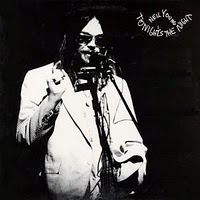 Neil’s finest record? Hard to say, but it’s my personal favorite: strange as only Neil can be, frightening, funny, sad, and sloppy as all-get-out, all the while being beautiful. Probably one of the four or five great guitar albums, too. It has that tossed-off feel that can either make or break a record; and it makes this one, in the same way that Exile on Main St. or the Velvets’ eponymous are made, by sounding so intense and so casual at the same time. Emotional intensity and casualness is a tough combination to arrive at, but, somehow, some can manage it – Neil more often than anyone, I dare say. And I can’t quite say why (though I can begin by remarking on the slide guitar and piano), but “Albuquerque” is my favorite Neil Young song, with that mournful chorus, “Oh, Albuquerque…” However often the album has been described as having the atmosphere of a wake… well, it has the atmosphere of a wake. –Will
Neil’s finest record? Hard to say, but it’s my personal favorite: strange as only Neil can be, frightening, funny, sad, and sloppy as all-get-out, all the while being beautiful. Probably one of the four or five great guitar albums, too. It has that tossed-off feel that can either make or break a record; and it makes this one, in the same way that Exile on Main St. or the Velvets’ eponymous are made, by sounding so intense and so casual at the same time. Emotional intensity and casualness is a tough combination to arrive at, but, somehow, some can manage it – Neil more often than anyone, I dare say. And I can’t quite say why (though I can begin by remarking on the slide guitar and piano), but “Albuquerque” is my favorite Neil Young song, with that mournful chorus, “Oh, Albuquerque…” However often the album has been described as having the atmosphere of a wake… well, it has the atmosphere of a wake. –Will
Jive Time Turntable
Parliament “Osmium” (1970)
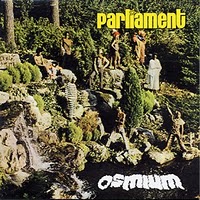 A trashy, kitschy, collage-like soul album in which Clinton begins to lay the ground of the P-funk sound. Those expecting the heavy psyched-out guitar rock of early Funkadelic will find this a little “poppy.” Those expecting the streamlined dancefloor grooves of Parliament will find this a little “rocky.” But this is no middle-ground record: they gospelize Pachelbel, dick around with country twang, and feature some bagpipes and harps in an ethereal soul workout about getting to the other side. It’s unlike anything else you’ve ever heard, though doubtless you’ve heard just about all of it: in the sampling of some rappist or another. –Will
A trashy, kitschy, collage-like soul album in which Clinton begins to lay the ground of the P-funk sound. Those expecting the heavy psyched-out guitar rock of early Funkadelic will find this a little “poppy.” Those expecting the streamlined dancefloor grooves of Parliament will find this a little “rocky.” But this is no middle-ground record: they gospelize Pachelbel, dick around with country twang, and feature some bagpipes and harps in an ethereal soul workout about getting to the other side. It’s unlike anything else you’ve ever heard, though doubtless you’ve heard just about all of it: in the sampling of some rappist or another. –Will
UFO “Phenomenon” (1974)
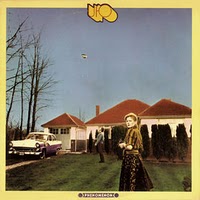 A good example of a band that didn’t achieve the success that matched the quality of their talent, would be, without a doubt, UFO. All of the ingredients were present, a guitar hero (Michael Schenker), a unique vocalist (Phil Mogg), a solid rhythm section, the power pop sensibilities of Cheap Trick and monster Sabbath riffs. Really, what more could a mid-seventies rock band need to be arena rock monsters. Their failure to appeal to the masses is a bit of a head-scratchier? Then again, as a teenager, I myself, considered them to be a B-level act. At the time, I wasn’t interested in subtleties, I was interested in rocking…hard. For some reason, diversity was alright for Led Zeppelin, but not for many others. It had to be loud, aggressive or progressive to cut through the hormonal fueled muck that was my sixteen year old brain. Still, somewhere in my self conscious, Phenomenon made an impression which led me to rediscover a hidden gem of an album and in turn, helped me rediscover UFO, All those years ago, my primitive mind could only wrap itself around “Rock Bottom” and “Doctor Doctor”. At the time, I considered these two, they only songs worth listening to on the entire album. The former built on a turbo charged upbeat intro riff, a half-time tempo shift and a classic seventies extended solo break in which Schenker pulls out all stops. The later was highlighted by tasteful fills and a bouncing shuffle beat, but what made these tracks stand out, was that they were the heaviest songs on this record. And HEAVY mattered more then anything. Now, older and wiser, I realize the album didn’t come close to ending there. “Too Young To Know” and “Oh My” are straight ahead root rockers, with earthy grooves and blues hooks the Stones made a somewhat nice living on. “Time on My Hands”, “Space Child” and “Crystal Light” are folkie ballads with stick-in-your-head melodies and unexpected twists. “Space Child” in particular, stands out with its’ loose structure and gripping solo. Less successful are “Built for Comfort”, which is a poor mans “Lemon Song”, and “Queen of the Deep”, which somewhat boldly meshes the folkie-UFO with the big riff-UFO, but misfires a bit in the attempt and fades just when it starts building momentum. The only real clunker is “Lipstick Traces”, which is basically just clichéd seventies filler. Believe me, these are small complaints. All in all, Phenomenon is not a Zeppelin album, but it would fit nicely in the same disc changer. –Rat Salad
A good example of a band that didn’t achieve the success that matched the quality of their talent, would be, without a doubt, UFO. All of the ingredients were present, a guitar hero (Michael Schenker), a unique vocalist (Phil Mogg), a solid rhythm section, the power pop sensibilities of Cheap Trick and monster Sabbath riffs. Really, what more could a mid-seventies rock band need to be arena rock monsters. Their failure to appeal to the masses is a bit of a head-scratchier? Then again, as a teenager, I myself, considered them to be a B-level act. At the time, I wasn’t interested in subtleties, I was interested in rocking…hard. For some reason, diversity was alright for Led Zeppelin, but not for many others. It had to be loud, aggressive or progressive to cut through the hormonal fueled muck that was my sixteen year old brain. Still, somewhere in my self conscious, Phenomenon made an impression which led me to rediscover a hidden gem of an album and in turn, helped me rediscover UFO, All those years ago, my primitive mind could only wrap itself around “Rock Bottom” and “Doctor Doctor”. At the time, I considered these two, they only songs worth listening to on the entire album. The former built on a turbo charged upbeat intro riff, a half-time tempo shift and a classic seventies extended solo break in which Schenker pulls out all stops. The later was highlighted by tasteful fills and a bouncing shuffle beat, but what made these tracks stand out, was that they were the heaviest songs on this record. And HEAVY mattered more then anything. Now, older and wiser, I realize the album didn’t come close to ending there. “Too Young To Know” and “Oh My” are straight ahead root rockers, with earthy grooves and blues hooks the Stones made a somewhat nice living on. “Time on My Hands”, “Space Child” and “Crystal Light” are folkie ballads with stick-in-your-head melodies and unexpected twists. “Space Child” in particular, stands out with its’ loose structure and gripping solo. Less successful are “Built for Comfort”, which is a poor mans “Lemon Song”, and “Queen of the Deep”, which somewhat boldly meshes the folkie-UFO with the big riff-UFO, but misfires a bit in the attempt and fades just when it starts building momentum. The only real clunker is “Lipstick Traces”, which is basically just clichéd seventies filler. Believe me, these are small complaints. All in all, Phenomenon is not a Zeppelin album, but it would fit nicely in the same disc changer. –Rat Salad
Rod Stewart “Every Picture Tells a Story” (1971)
 Rod Stewart was Rod Stewart before he became Rod Stewart. When he was Rod Stewart, he recorded a handful of extraordinary albums, both as a solo artist and as a member of the mighty Faces. This one’s arguably the best LP of the lot. Here are just a few reasons: The title track; “(I Know) I’m Losing You,” which might be the best cover tune in history; the drumming throughout the record, but especially on the aforementioned title track; the wonderful, organic sound, with acoustic guitars that are heavy, warm, and propulsive, and the electric guitar of Ron Wood, who might’ve been the best of his generation, or at least the coolest; the emotional range of the record, which is full of humour and pathos and the kind of spontaneous rawkousness that you just don’t hear anymore. Did I mention the title track? –Will
Rod Stewart was Rod Stewart before he became Rod Stewart. When he was Rod Stewart, he recorded a handful of extraordinary albums, both as a solo artist and as a member of the mighty Faces. This one’s arguably the best LP of the lot. Here are just a few reasons: The title track; “(I Know) I’m Losing You,” which might be the best cover tune in history; the drumming throughout the record, but especially on the aforementioned title track; the wonderful, organic sound, with acoustic guitars that are heavy, warm, and propulsive, and the electric guitar of Ron Wood, who might’ve been the best of his generation, or at least the coolest; the emotional range of the record, which is full of humour and pathos and the kind of spontaneous rawkousness that you just don’t hear anymore. Did I mention the title track? –Will
Vince Guaraldi “A Charlie Brown Christmas” (1965)
 This is a near perfect Christmas album, and is rightly considered as one of Vince Guaraldi’s greatest works. In my house at least, no Christmas can be complete without this seasonal slice of musical beauty. From the first few notes it sets a mood so completely and utterly that the spell isn’t broken until the album finishes and the room goes silent once more at its conclusion. It’s a beautiful album which is as wistful and melancholy as it is joyful. Not that the music itself is sad, but there’s something about this album which never fails to get me choked up. Perhaps it’s the fact that this music is all tied up with my childhood memories of the Charlie Brown Christmas special, which has to be one of the bleakest, most depressing television programs ever foisted upon the impressionable youth of North America. However, all this heaviness is wonderfully offset by the gorgeous “Skating”, which has always been my favourite song on this album. What more can I say? For me this is a deeply moving and emotional album despite the lurid cartoon characters which populate its cover. Beautiful, essential, golden. –Deadlybreakfast
This is a near perfect Christmas album, and is rightly considered as one of Vince Guaraldi’s greatest works. In my house at least, no Christmas can be complete without this seasonal slice of musical beauty. From the first few notes it sets a mood so completely and utterly that the spell isn’t broken until the album finishes and the room goes silent once more at its conclusion. It’s a beautiful album which is as wistful and melancholy as it is joyful. Not that the music itself is sad, but there’s something about this album which never fails to get me choked up. Perhaps it’s the fact that this music is all tied up with my childhood memories of the Charlie Brown Christmas special, which has to be one of the bleakest, most depressing television programs ever foisted upon the impressionable youth of North America. However, all this heaviness is wonderfully offset by the gorgeous “Skating”, which has always been my favourite song on this album. What more can I say? For me this is a deeply moving and emotional album despite the lurid cartoon characters which populate its cover. Beautiful, essential, golden. –Deadlybreakfast
Weezer “Weezer” (1994)
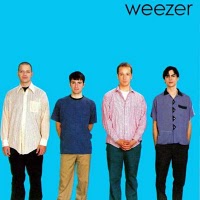 The great tunes here deal with sex (as great songs usually do), such as “Undone (The Sweater Song)” and “Only in Dreams.” The epic “Say it Ain’t So” is one of the best songs of the decade, period. The band doesn’t waste time noodling around and every track sounds punchy and vital. Another positive are the smart lyrics. Not smart because they try to be clever – quite the opposite, actually. Every word rings true, which is quite a feat considering they aren’t masked by slick wordplay or attempts at poetic garbage. Cuomo writes pop songs as perfect as Oasis thinks theirs are. Somehow, the band filters them through the type of sun-drenched garage sensibility that is usually reserved for SoCal bands only. Finally, Weezer never overreaches or missteps, making this a thoroughly enjoyable experience from start to finish. –Lucus
The great tunes here deal with sex (as great songs usually do), such as “Undone (The Sweater Song)” and “Only in Dreams.” The epic “Say it Ain’t So” is one of the best songs of the decade, period. The band doesn’t waste time noodling around and every track sounds punchy and vital. Another positive are the smart lyrics. Not smart because they try to be clever – quite the opposite, actually. Every word rings true, which is quite a feat considering they aren’t masked by slick wordplay or attempts at poetic garbage. Cuomo writes pop songs as perfect as Oasis thinks theirs are. Somehow, the band filters them through the type of sun-drenched garage sensibility that is usually reserved for SoCal bands only. Finally, Weezer never overreaches or missteps, making this a thoroughly enjoyable experience from start to finish. –Lucus
Armageddon “Armageddon” (1975)
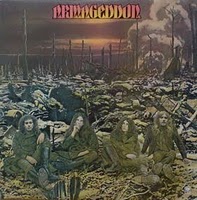 Shaggy proto-metal stretched and contorted into long winded, progressive forms, second tier supergroup Armageddon recall the similarly assembled Captain Beyond in both form and execution, both bands in fact sharing a member in drummer Bobby Caldwell. Ex-Yardbirds and Renaissance vocalist Keith Relf fronts the group, while Steamhammer’s Martin Pugh lays down piercing, wah-washed guitar on the circling “Buzzard,” slashes and burns through the frantic “Paths and Planes and Future Gains,” and works a heavy funk riff ala Zeppelin and Budgie on “Last Stand Before.” Elsewhere there’s the glassy tones of the ethereal “Silver Tightrope,” and the album concludes with a rambiling, multi-part suite in “Basking in the White of the Midnight Sun.” An impressive, semi-obscure heavy gem that any fan of bludgeoning bell-bottom rock should enjoy surrendering to. –Ben
Shaggy proto-metal stretched and contorted into long winded, progressive forms, second tier supergroup Armageddon recall the similarly assembled Captain Beyond in both form and execution, both bands in fact sharing a member in drummer Bobby Caldwell. Ex-Yardbirds and Renaissance vocalist Keith Relf fronts the group, while Steamhammer’s Martin Pugh lays down piercing, wah-washed guitar on the circling “Buzzard,” slashes and burns through the frantic “Paths and Planes and Future Gains,” and works a heavy funk riff ala Zeppelin and Budgie on “Last Stand Before.” Elsewhere there’s the glassy tones of the ethereal “Silver Tightrope,” and the album concludes with a rambiling, multi-part suite in “Basking in the White of the Midnight Sun.” An impressive, semi-obscure heavy gem that any fan of bludgeoning bell-bottom rock should enjoy surrendering to. –Ben
Little Feat “Sailing Shoes” (1972)
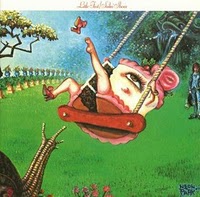 This wonderfully bizarre album cover hides the secret love child of ZZ Top’s “Tres Hombres” and The Stone’s “Exile on Main Street.” “Sailing Shoes” is an eclectic mix of rock, country, blues and gospel that avoids the Southern and country-rock cliches and is experimental enough to reward repeated listening. In the past, when I’ve thrown on The Allman Brothers or Dr. John, I’ve been disappointed because THIS was the album I wanted to hear all along! It’s a rare album that transcends genres and consistently surpasses expectations but Little Feat has done it here. If you love seventies rock slip on “Sailing Shoes,” walk over to Jive Time and thank me! (And then pick up the equally impressive “Dixie Chicken.”) –David
This wonderfully bizarre album cover hides the secret love child of ZZ Top’s “Tres Hombres” and The Stone’s “Exile on Main Street.” “Sailing Shoes” is an eclectic mix of rock, country, blues and gospel that avoids the Southern and country-rock cliches and is experimental enough to reward repeated listening. In the past, when I’ve thrown on The Allman Brothers or Dr. John, I’ve been disappointed because THIS was the album I wanted to hear all along! It’s a rare album that transcends genres and consistently surpasses expectations but Little Feat has done it here. If you love seventies rock slip on “Sailing Shoes,” walk over to Jive Time and thank me! (And then pick up the equally impressive “Dixie Chicken.”) –David
XTC “Black Sea” (1980)
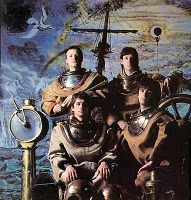 By 1980’s “Black Sea” XTC were fully into their stride, the previous years exceptional “Drums And Wires” remains an early high water mark yet “Black Sea” sees them expanding their sound further, moving away from the angular, sparky new wave of that album and towards a tougher, rockier sound, as such it’s arguably their most accessible of all their early albums. A 60’s feel is beginning to rear it’s head in a lot of their work, take for instance “Respectable Street” and “Towers Of London,” the former has strong echoes of mid 60’s Kinks whilst the latter is pure “Rubber Soul” era Beatles, both given a punkish twist, “No Language In Our Lungs” also has a strong Beatles influence but still manages to sound typically XTC. Where “Drums And Wires” was rough around the edges “Black Sea” is a lot more focused and less artsy sounding, still this is XTC so fans of their artsy leanings can always revel in “Travels In Nihilon’s” apocalyptic soundscape or “Living Through Another Cuba’s” dub infused paranoia but overall Black Sea is a lot more polished and poppy than anything the band had recorded since their spiky, charming debut. “Generals And Majors,” “Love At First Sight,” “Rocket From A Bottle,” “Paper And Iron” and “Burning With Optimism’s Flames” would all have made great singles, strange then that they chose to release arguably the album’s weakest track, the XTC by numbers of “Sgt Rock,” still it’s one misstep on an otherwise blemish free album, I prefer the jittery, nervous “Drums And Wires” ever so slightly but that does not diminish “Black Sea’s” tough majesty. Yet another classic from England’s most underrated band. –Derek
By 1980’s “Black Sea” XTC were fully into their stride, the previous years exceptional “Drums And Wires” remains an early high water mark yet “Black Sea” sees them expanding their sound further, moving away from the angular, sparky new wave of that album and towards a tougher, rockier sound, as such it’s arguably their most accessible of all their early albums. A 60’s feel is beginning to rear it’s head in a lot of their work, take for instance “Respectable Street” and “Towers Of London,” the former has strong echoes of mid 60’s Kinks whilst the latter is pure “Rubber Soul” era Beatles, both given a punkish twist, “No Language In Our Lungs” also has a strong Beatles influence but still manages to sound typically XTC. Where “Drums And Wires” was rough around the edges “Black Sea” is a lot more focused and less artsy sounding, still this is XTC so fans of their artsy leanings can always revel in “Travels In Nihilon’s” apocalyptic soundscape or “Living Through Another Cuba’s” dub infused paranoia but overall Black Sea is a lot more polished and poppy than anything the band had recorded since their spiky, charming debut. “Generals And Majors,” “Love At First Sight,” “Rocket From A Bottle,” “Paper And Iron” and “Burning With Optimism’s Flames” would all have made great singles, strange then that they chose to release arguably the album’s weakest track, the XTC by numbers of “Sgt Rock,” still it’s one misstep on an otherwise blemish free album, I prefer the jittery, nervous “Drums And Wires” ever so slightly but that does not diminish “Black Sea’s” tough majesty. Yet another classic from England’s most underrated band. –Derek
The David “Another Day Another Lifetime” (1967)
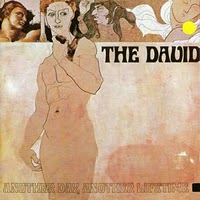 The David didn’t really blaze any new “freak” avenues, but they have songs falling nicely beyond the mid-60’s three chord thump-mmmm-bump. I guess they sound like a better Stateside garage band who took steps into the “psychedelic” while retaining “garage” energy, and staying smartly this side of “hippie.” It paid off for them at the time… they got some airplay, even charted locally, but too bad it wasn’t enough for the squares to remember them. This has become a hard-to-find record, but when and if you can snatch it! –Nipper
The David didn’t really blaze any new “freak” avenues, but they have songs falling nicely beyond the mid-60’s three chord thump-mmmm-bump. I guess they sound like a better Stateside garage band who took steps into the “psychedelic” while retaining “garage” energy, and staying smartly this side of “hippie.” It paid off for them at the time… they got some airplay, even charted locally, but too bad it wasn’t enough for the squares to remember them. This has become a hard-to-find record, but when and if you can snatch it! –Nipper
Miles Davis “In A Silent Way” (1969)
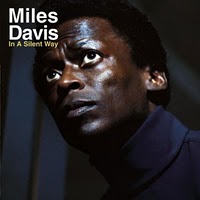 As a teen, I fancied myself a jazz drummer, and listened to plenty of complicated-for-complicated’s sake drummers, thinking that if I could figure out how to cram eleven notes into a three note space, I’d have it all figured out. And then I discovered “In A Silent Way”, and my mind was sufficiently blown. “Shhh/Peaceful” is entirely 16th notes on the hi-hat (and nothing more) and a two note mantra on the bass, while the best collection of instrumentalists available (Hancock, Corea, Shorter, McLaughlin, Zawinul) vamp over the top. Miles himself is restrained, compared to his other recordings of this period, giving the album a late night, quiet vibe. The best elements from these extensive sessions were spliced together from tape by Teo Macero to create two massive songs, in what could be argued as an early form of remixing. Simplicity. It’s an underrated thing, especially in jazz. –Cameron
As a teen, I fancied myself a jazz drummer, and listened to plenty of complicated-for-complicated’s sake drummers, thinking that if I could figure out how to cram eleven notes into a three note space, I’d have it all figured out. And then I discovered “In A Silent Way”, and my mind was sufficiently blown. “Shhh/Peaceful” is entirely 16th notes on the hi-hat (and nothing more) and a two note mantra on the bass, while the best collection of instrumentalists available (Hancock, Corea, Shorter, McLaughlin, Zawinul) vamp over the top. Miles himself is restrained, compared to his other recordings of this period, giving the album a late night, quiet vibe. The best elements from these extensive sessions were spliced together from tape by Teo Macero to create two massive songs, in what could be argued as an early form of remixing. Simplicity. It’s an underrated thing, especially in jazz. –Cameron
The Rolling Stones “Some Girls” (1978)
 When I was in school the rules were clear: Rock ruled. Disco and punk sucked. The end. As a devoted rocker I carried my KISW “Disco Sucks” club card in my wallet and expressed disgust whenever Donna Summer or the Sex Pistols were mentioned (having never actually heard either). Then something miraculous happened: The Rolling Stones released “Some Girls.” The Stones’ ability to blend rock, blues and country with the seemingly polarizing disco and punk made me realize for the first time that it was all related and that it was all rock and roll! Pre-internet, this album was also my portal to a world outside of the suburbs of Seattle. I’ll never forget the first time I heard the sleazy “Shattered,” and prowling “Miss You” on the radio, flooding me with images of a gritty, decadent New York. The sexually charged lyrics, androgynous imagery and Jagger’s swagger (along with the infamous SNL appearance promoting the album) suggested a sexual world infinitely more complex and exciting than the black and white one previously painted for me by the likes of Kiss and Aerosmith. Even the Warhol-esque, die-cut cover’s tabloid kitsch influenced the way I thought about art and design. Best of all, “Some Girls” sounds as fresh to me today as it did in ’78 and continues to hold a coveted top spot in my record collection. Some Girls. Some album! –David
When I was in school the rules were clear: Rock ruled. Disco and punk sucked. The end. As a devoted rocker I carried my KISW “Disco Sucks” club card in my wallet and expressed disgust whenever Donna Summer or the Sex Pistols were mentioned (having never actually heard either). Then something miraculous happened: The Rolling Stones released “Some Girls.” The Stones’ ability to blend rock, blues and country with the seemingly polarizing disco and punk made me realize for the first time that it was all related and that it was all rock and roll! Pre-internet, this album was also my portal to a world outside of the suburbs of Seattle. I’ll never forget the first time I heard the sleazy “Shattered,” and prowling “Miss You” on the radio, flooding me with images of a gritty, decadent New York. The sexually charged lyrics, androgynous imagery and Jagger’s swagger (along with the infamous SNL appearance promoting the album) suggested a sexual world infinitely more complex and exciting than the black and white one previously painted for me by the likes of Kiss and Aerosmith. Even the Warhol-esque, die-cut cover’s tabloid kitsch influenced the way I thought about art and design. Best of all, “Some Girls” sounds as fresh to me today as it did in ’78 and continues to hold a coveted top spot in my record collection. Some Girls. Some album! –David


